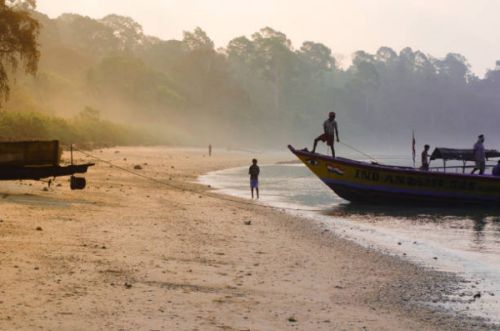The enigmatic inhabitants of North Sentinel Island, the Sentinelese, have long captivated the attention of anthropologists and cultural theorists alike. Located within the Andaman and Nicobar archipelago, these individuals remain one of the last uncontacted peoples on Earth. The query, “Are North Sentinel Island people African?” warrants an examination that is not merely surface-level but rather delves deeply into the cultural relativism perspective, allowing for a nuanced understanding of their origins and societal constructs.
To comprehensively address this question, it is pivotal to dissect the geographic, historical, and anthropological dimensions surrounding the Sentinelese. The Andaman Islands, situated in the Bay of Bengal, are geographically closer to Southeast Asia than to Africa. However, the origins of the Sentinelese cannot be encapsulated in a simplistic geographic frame; they require a multifaceted exploration that acknowledges the fluidity of human migration and the complexities of cultural identity.
Anthropological evidence suggests that the human population of the Andaman Islands has origins that date back at least 26,000 years. These early inhabitants were likely part of the great waves of migration that populated the region from Africa through Asia. Genetic research indicates that the Sentinelese, along with other indigenous groups of the Andaman Islands, share ancestry with some of the earliest human populations that dispersed out of Africa. While this connection is primarily genetic, it highlights the common lineage that connects the inhabitants of far-flung regions through millennia of migration.
From a cultural relativism perspective, the Sentinelese cannot be deemed African in the contemporary sociocultural sense. Cultural relativism posits that one’s culture must be understood on its own terms, against the backdrop of its unique historical and environmental contexts. The Sentinelese have developed a distinct culture characterized by their subsistence strategies, social organization, and cultural practices. Their way of life is wholly adapted to the exigencies of their island environment—engaging in fishing, gathering, and hunting using methods that have prevailed for thousands of years. This intricate relationship with their environment underscores a profound aspect of their identity, which is intricate and localized rather than derived from an external source.
Exploring their sociocultural practices, one notes the Sentinelese social structure, which is believed to be egalitarian. Their communal living arrangements and cooperative hunting endeavors reveal a deep-seated interdependence among individuals. Rather than aligning with hierarchical power structures often observed in more populous societies, the Sentinelese exemplify a robust sense of communal identity, where identity is intertwined with their natural environment and kinship ties. Their resistance to outside influences is notable; they vehemently protect their autonomy, using physical means to deter contact with outsiders. Such actions can be understood through the lens of cultural relativism as a form of agency aimed at preserving their unique identity.
The island’s isolation has facilitated the preservation of their distinct culture, yet it has also engendered its own set of challenges, particularly concerning outside perceptions and interventions. In an era of globalization, they serve as a poignant reminder of cultural diversity and the ethical complexities that arise when interacting with uncontacted groups. This duality—celebration of diversity alongside ethical quandaries—underscores why simplistic categorizations fall short; the Sentinelese are not merely ‘African’ or ‘Asian,’ but rather an embodiment of a unique cultural tapestry amalgamated through the eons.
Moreover, the concept of ‘the Other’ is profoundly relevant when discussing the Sentinelese. They have often been characterized as primitive or savage within colonial discourse, a perspective steeped in ethnocentrism and a lack of understanding. Such narratives overlook the sophisticated ecological knowledge and survival strategies that define their existence. Cultural relativism urges us to dismantle these stereotypes. By recognizing the context-specific knowledge and customs of the Sentinelese, we promote a deeper appreciation for human diversity that transcends mere geographic boundaries.
Furthermore, examining the contemporary implications of cultural relativism in relation to the Sentinelese involves assessing the role of Western knowledge systems and their imposition upon non-Western cultures. Watching their way of life through a Eurocentric lens often leads to a misunderstanding of their motivations and actions. For instance, attempts to forcibly integrate them into the modern world, often justified in terms of altruism or humanitarianism, can result in catastrophic consequences. The introduction of foreign diseases, cultural disintegration, and loss of autonomy are some of the perils they face. Ethically, respecting their right to remain uncontacted becomes integral—a fundamental premise within cultural relativism.
In conclusion, the inquiry into whether the North Sentinel Island people can be classified as African necessitates a broader contextual analysis that stretches beyond geographical categorizations. It requires an understanding of the fluid dynamics of human migration, the unique cultural constructs that shape their identity, and the ethical considerations inherent in our interactions. As we honor the Sentinelese, let us approach with humility and a commitment to appreciating their distinct culture as an isolative yet richly woven thread in the intricate tapestry of human civilization.
